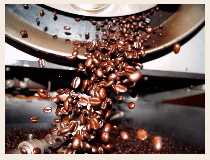
In larger operations, bags of green coffee beans are hand or machine-opened, dumped into a hopper, and screened to remove debris. The green beans are then weighed and transferred by belt or pneumatic conveyor to storage hoppers. From the storage hoppers, the green beans are conveyed to the roaster. Roasters typically operate at temperatures between 370 and 540 °F (188 and 282 °C), and the beans are roasted for a period of time ranging from a few minutes to about 30 minutes. Roasters are typically horizontal rotating drums that tumble the green coffee beans in a current of hot combustion gases; however some other common types of roasters use electricity or even heat from wood. The roasters operate in either batch or continuous modes and can be indirect- or direct-fired.

Many people who roast coffee prefer to follow a "recipe" when bringing out the flavor characteristics they wish to highlight. This recipe is often referred to as a roast profile. Any number of factors may help a person determine the best profile to use, such as the coffee's origin, varietal, processing method or desired flavor characteristics. A common way of expressing a roast profile is by using a graph showing time on one axis and temperature on the other, which can be recorded manually or using computer software and data loggers linked to temperature probes inside various parts of the roaster. As time elapses and the temperature of the coffee beans rises inside the roaster the person roasting is able to refer to a previously recorded profile in order to match the profiles for consistency from batch to batch.
Indirect-fired roasters are roasters in which the burner flame does not contact the coffee beans, although the combustion gases from the burner do contact the beans. Direct-fired roasters contact the beans with the burner flame and the combustion gases. At the end of the roasting cycle, water sprays are used to "quench" the beans. Following roasting, the beans are cooled and run through a "destoner". Destoners are air classifiers that remove stones, metal fragments, and other waste not removed during initial screening from the beans. The destoners pneumatically convey the beans to a hopper, where the beans are stabilized and dried (small amounts of water from quenching exist on the surface of the beans). This stabilization process is called equilibration. Following equilibration, the roasted beans are either ground by multi-stage grinders or packaged as whole beans. Roasted whole beans can be considered fresh for up to, but not exceeding one month. Once coffee is ground it is only good for about 24 hours.
Information Source: Wikipedia and Image Source: Coffe Fair
Roasting
Roasting Overview | Roasting Process | Roast Guide
Home Roasting
Home Roasting Overview | Stove Top Method | Air Popper Method
Oven Method | Skillet Method | Machine


















































